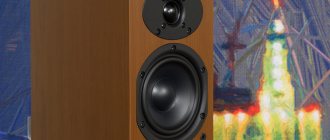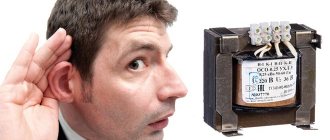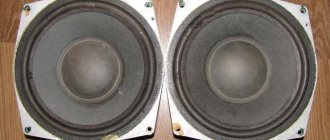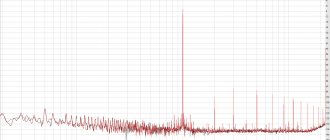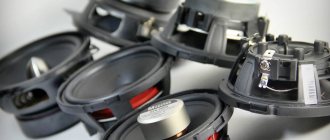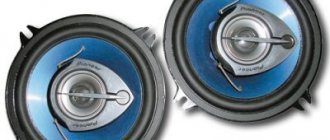The most common mistakes when building subwoofers
The ideal subwoofer is one that is designed to suit the music you listen to, the car you drive in, and the rest of your speaker system. There are many mistakes you can make when building a subwoofer if you don't know how to do it correctly. As a result, he may play poorly or not play as well as he could. If you make particularly serious mistakes, you can create conditions under which the speaker will be much easier to damage. What mistakes can be made when building subwoofers?
1. mistakes when building subwoofers , when it is done at random. Yes, it also happens when, to build a subwoofer box, they make a box from the remaining scraps of lumber, with the volume that will be obtained, in the hope that it will suddenly play? This is a serious mistake, since different speakers require different amounts of acoustic design. It's also a very stupid mistake because after spending time assembling and finishing the box, it's a shame to end up with a non-playing sub.
2. mistakes when building subwoofers, when using drawings from the Internet, you can either get a subwoofer that plays well, or one that plays frankly poorly. It depends on your luck. Even if the size of your speaker and the size of the speaker in the drawing are the same, this does not at all guarantee good and correct operation of the woofer. Since each speaker has its own electromechanical characteristics, they must be taken into account when calculating.
3. errors in the construction of subwoofers - incorrect type of acoustic design. Each speaker requires its own acoustic design. For one it is a closed box, for another it is a bass reflex, for a third it is free air. By installing a speaker in a closed box that is designed to be free-standing in the rear parcel shelf, you can get booming, unpleasant and irritating bass. If you install a speaker designed for box installation into a shelf, you can simply damage it by adding a little volume.
4. errors in the construction of subwoofers, when the incorrect volume of the box is calculated. Subwoofer speakers of different diameters require boxes of different volumes. Moreover, for the same speaker in a closed box and a bass reflex enclosure, different volumes are needed, which differ by several tens of liters. And for acoustic design of the “quarter-wave resonator” type, the boxes turn out to be quite gigantic in size.
5. errors when building subwoofers, when the port is incorrectly calculated. For each speaker, based on the required volume, you need to calculate the volume of the port, its length and area (if it is a bass reflex case). It will not be possible to make a port at random, since the programs, according to their formulas, calculate the port specifically for a given speaker and a given volume of the box. If done incorrectly, the box may play quieter than it could, or with various noises and sound artifacts such as buzzing, whistling, or popping. This will sound very bad to the ear.
Also, when building a subwoofer, music, your car and amplifier power may not be taken into account. This happens when you buy a ready-made subwoofer in a store. It is made for some average consumer who drives an average car and listens to average music. Such a “sub,” of course, will play, but worse than it could play if it was made to individual requirements.
For example, if you like to listen to rap, trap, and install a 10-inch speaker in a closed box, then by turning up the volume to get deep and low bass, you will simply damage the speaker by pushing its coil to maximum travel. Or you want to listen to a jazz concert, and you have a 15-inch subwoofer, in a 130-liter huge box with a bass reflex. He simply will not be able to play well those low frequencies that are present in jazz.
Another example: you make a large box without taking into account the power of your amplifier, which is twice the rated power than the speaker can “digest.” As a result, the speaker will be damaged in the same way, because it simply has nothing to “rely on” during operation.
Therefore, try not to make the described mistakes when building subwoofers, calculate, make subwoofers correctly and they will delight you with their sound. And you will enjoy the quality of work done.
Why did the sound transmission deteriorate?
The first thing you should pay attention to if you notice that the sound of the speakers has deteriorated and extraneous noise is coming from them is the integrity of the cable. Check its entire length for damage, for example:
- kinks;
- breaks in the braid;
- are there any internal wire fractures?
- it was not chewed by pets;
If the cable is detachable, connect it to another device and check there.
Damage to connectors. Sooner or later, with active use of the device, its connectors wear out. This is noticeable, for example, by the play of the plug, but it should fit tightly. Try pulling out the plug, then reinserting it, twisting it in the socket. Noise will immediately be heard from the speakers.
REFERENCE! If it is not possible to purchase new speakers, then you can simply fix the cable in its normal state, in which it does not cause interference.
Very long cable. Often the sound is distorted due to the fact that there are a large number of kinks in the cable, especially if it is very long and the distance to the computer is not particularly large. In such a case, try to maintain the cable installation that was made at the factory.
Operation of faulty connectors. As a rule, any system unit has two inputs for connecting audio systems. One is located on the front panel of the case, and the second is on the motherboard. The front connector very quickly becomes unusable and begins to work poorly, or even does not detect the device at all.
Binding. Many computer owners like to intertwine wires with each other so that they do not stick out in different directions. But this entails cable kinks, and as a result, humming.
Fighting interference in the amplifier.
In this article I will share my experience in dealing with interference, noise, hum, and interference in low-frequency amplifiers. I'll tell you about the reasons for their occurrence.
Interference
Interference in a low-frequency amplifier can be both internal and external.
Internal interference may be due to:
- Poor quality power supply or defective supply circuits. With such a deficiency, it begins to “choke”, that is, when the volume increases, distortion appears. Diagnosing such a deficiency is quite simple. It is necessary to measure the voltage at the output of the power supply, as well as on the board of the amplifier itself at maximum and minimum volume. There should not be a large voltage drop. When manufacturing a device from ready-made boards, I very often encountered loss of mass (minus), to eliminate this problem you need to throw a wire from the minus of the power supply to the minus at the amplifier input terminal, output terminal and to the housing of the variable resistor.
- Perhaps the most common phenomenon is “50 Hz interference,” which is associated with voltage ripples in the network. To combat them, you can experiment with the capacitance of the filter element capacitors. (YOU SHOULD KNOW THAT WHEN THE CAPACITY OF THE CAPACITOR INCREASES, THE VOLTAGE INCREASES; experimenting with electrolytes at the output of the stabilizer should not get carried away). You can add a choke to the supply circuit. Shield the preliminary stage and place it as far as possible from noise sources.
Electrolytic capacitors from unscrupulous manufacturers may lose their properties even when stored in a box. The swelling of such a capacitor tells us that it has become unusable. But the capacitor does not always swell. To diagnose the performance of the capacitor, I recommend using an ESR meter. Fortunately, our Chinese friends make interesting devices at an affordable price.
External interference is caused by the influence of external devices on the amplifier. For example, switching power supplies, motors, magnetic radiation sources.
To reduce the impact of external sources of interference, you should:
- Apply shielding of input circuits.
- Place the amplifier board as far as possible from devices that create interference.
When assembling yourself you should:
The wires used to supply the signal to the input circuits should be shielded and as short as possible. It is advisable to have a separate shielded wire for each channel. Also, when designing a printed circuit board, the tracks should be kept as short as possible. Their location can also have an effect.
Amplifier noise (hiss)
The hiss of the amplifier is associated with a design feature, as well as with the noise of the radio elements themselves. It will be hard to overcome him.
That's all. If you have comments or suggestions regarding this article, please write to the site administrator, or comment under this article.
Good luck!
Speakers hum when you pick up your phone
Speakers often make noise and produce interference when your mobile device receives an SMS or suddenly starts ringing. Actually, any equipment that has an antenna leads to similar effects in the speakers. But sometimes printers and even table lamps can cause them. Try to move potential sources of interference away from your computer one at a time and this way you can find the culprit.
Constant humming from your speakers when they're turned on is mostly normal. Not that it should be so, but it is simply related to the circuit design of the sound card and the speakers themselves. This happens due to the fact that if the sound card does not receive power, then it begins to pick up any interference from everything around it. To get rid of this, you need to ground the computer case and reduce the input impedance of the speakers to about 20 kOhm.
The acoustics are humming - what's the reason? My view on this problem
Where do you think the rule came from not to place speakers with a rear bass reflex against the wall? And why is it so persistently advised to place speakers in the middle of the room?
Unfortunately, few people understand the reason for this, due to the fact that they do not have certain knowledge and do not understand the essence of “Sound Propagation”.
I think it’s worth starting with what is meant by the concept of “standing close to the wall.” This means that the bass reflex is closed and does not work. For this reason, speaker manufacturers used to write recommendations not to place them close to the wall. In my opinion, 10 cm from the wall to the speaker cabinet is enough.
About the hum
A. Klyachin correctly noted that hum is characteristic of speakers with initially raised bass. I completely agree with this, since crafty manufacturers like to raise the 80-150 Hz band in their speakers to a level of up to +6 dB and firmly declare “Bass speakers.”
Who has a speaker with a bass reflex to the floor?
With a floor-standing bass reflex, you can imagine all the way, that is, from the bass reflex to the floor there may be 10-5 cm and there’s nothing buzzing...
That is, the essence of the hum is that the speakers are not designed correctly. Competent acoustics will not hum due to proper calculation, namely “The bass reflex must be tuned to low frequencies, approximately 25-30 hertz.” Alas, this is possible with large woofers of 20-30 cm or more. Nowadays, the “golden solution” has become 13.5 - 17 cm woofers, and therefore their bass reflex is set to 40-60 hertz.
Moreover, few people know that below the bass reflex tuning frequency an “acoustic short circuit” occurs, that is, the sound pressure drops 24 dB per octave, and there is simply nowhere to get bass. With a highly tuned bass reflex, no room will raise the bass.
As many “gurus” here write, you can’t place speakers against the wall at all, because the bass region is distorted and the speakers produce smeared bass. And it doesn’t matter if it’s in front or behind. There is another incredible belief in plugging the bass reflex with foam socks and other “porn things”.
For some reason, everyone is sure that it is the trumpet that produces the bass, and not the speaker. They say the speaker below cannot sound and a pipe 10-15 cm long produces “super bass”. Complete misconception and nonsense.
A hole in the pipe cannot produce bass at all because it is an additional brake on the speaker membrane. It is the brake, not the bass that is the secret. It is unlikely that anyone knows the principle of operation of the bass reflex and what it inverts there. Everyone is sure that “HE gives BASS.”
But it does not give “Bass” but makes it possible to reduce (the linear stroke of the speaker membrane) the distortion of the speaker when it plays at the resonance frequency. That is, since the speaker has a maximum stroke at the resonant frequency, then at a certain power it can reach the limit of the linear stroke of the diffuser, because at the resonance frequency the stroke is maximum.
The bass reflex is adjusted either to the resonance frequency of the speaker, or even lower. Why do they set it even lower? As I wrote above, “below the tuning frequency an acoustic short circuit occurs” with a drop-off of 24 dB/octave. It is to eliminate this that the phasic setting is shifted lower, so that the listening room can thus add a little more low frequency.
When you plug the bass reflex, on the one hand you “increase the resonance frequency of the Speaker Box”, and on the other hand you remove the speaker membrane damper and it runs with underdamping, which gives rise to distortions and overtones. Want to check it out? This is easier to do if the phasic is in front. Turn on a music track with bass so that the movement of the speaker is noticeable. Place your finger on the membrane to fix the speaker movement. and keep your finger at a distance so that it barely touches the membrane. Now close the bass reflex tightly with your palm or other material. and you will see that the stroke of the speaker membrane will increase significantly. It will touch your finger more strongly. An example quite convenient to implement to understand the meaning of a bass reflex and its physical essence.
Therefore, let me remind you that the bass reflex of a competent speaker must be correctly configured. But now, in the age of “campus modeling” and the release of consumer goods, no one is interested in making high-quality speakers. Therefore, every year manufacturers produce all sorts of clones of their speakers, assuring that this version has a revolutionary super development speaker and other “nano” technologies, just to sell the next product.
Think for yourself, does the manufacturer really not know how speakers are installed in living rooms in most cases? Do you naively believe that he places all the speakers one meter from the wall? It’s just that no one wants to optimize speakers for competent sound, it’s expensive. So they produce a semi-finished product that hums against the wall, in the corners, etc., in the hope of “nothing, they will suffer and buy new ones.”
I also want to draw attention to the currently fashionable built-in speakers. In the walls, ceilings, etc.... I agree that such options do not provide bass. But based on their features, they sound better than speakers standing “from the wall”.
But that's another topic...
How to get the best performance from your subwoofer.
Subwoofers are great at making music loud, but only up to a point. For example, if you don't adjust the subwoofer correctly, your music may sound distorted and too loud. The trick is to set the volume of your subwoofer in your car correctly so that the strong bass doesn't make your car burst at the seams. Fortunately, setting the settings is very easy. You can do this in just a few seconds.
Subwoofer: purpose and device
High-quality sound cannot be imagined without good transmission of low tones. Unfortunately, the standard speakers installed in cars by default do not cope well with this task. Need a subwoofer.
Not every car enthusiast has a subwoofer, but probably everyone can imagine what it looks like: a hefty speaker that takes up half (at best) of the trunk. Why does the subwoofer have to be big? Strictly speaking, a large diffuser size is not needed for high-quality transmission of low frequencies - any good headphones are capable of transmitting the “low frequencies” in all their richness, despite the size of the diffuser being tens of times smaller than that of a subwoofer. The problem is the sound pressure created by the speakers. It is not difficult to create sound pressure in a small volume between the ear and the headphones; it is another matter when we are talking about at least the volume of air inside the car. And here, the lower the frequency, the slower the diffuser moves and the more difficult it is to create the necessary sound pressure. A diffuser with a small diameter must have a very large stroke so that as the volume increases, the sound pressure at lower frequencies remains the same as at high frequencies - so that the “lows do not sag.” And if you want to listen to music very loudly, and even with enhanced bass, then no standard speaker will cope - you need to increase the size of the diffuser.
Another feature of the subwoofer - both in stereo systems and in surround sound systems - is that there is always one (this is also known to many, although not everyone knows why this is so). The fact is that a person has difficulty determining the direction of a low-frequency sound source. Because the sound wavelength is comparable to the distance between the ears, both of our methods for determining the direction of the sound source do not work. The attenuation of the sound is indistinguishable (the wave simply bends around the head and sounds in both ears with the same intensity), and it is also impossible to determine the direction by the phase shift (the peak of the signal arrives in both ears at the same time). Therefore, one subwoofer is quite enough - if there is no high-frequency signal going to it, it will not be possible to determine where it is installed.
Why do many small subwoofers cost more than larger ones? What is the difference between expensive and cheap models, besides power? Firstly, in a combination of power (preferably more), sound pressure (also more) and size (smaller). The requirements are mutually exclusive, therefore, the closer a manufacturer manages to bring its product to an unattainable ideal, the more expensive materials and engineering solutions are used in it. Secondly, in terms of sound quality: in the pursuit of power, many manufacturers leave the issue of quality “behind the scenes” - after all, it requires the use of high-quality (and therefore expensive) materials for the diffuser and subwoofer housing.
Set the right volume
Have you driven in a car that has a subwoofer installed, or perhaps been in someone's house where there is a subwoofer as an addition to the stereo and speakers?
If yes, then you have probably encountered the wrong setting of the subwoofer more than once - usually this is indicated by a too loud sound that hits the ears hard. Yes, of course, as they say, there is no arguing about tastes. See also How to automatically turn on speakerphone mode for an incoming call on iPhone
Maybe someone likes strong bass. But there is a limit to everything. Even those who are crazy about powerful bass in music need to remember that an incorrectly configured subwoofer can actually ruin the entire quality of the music. And the main rule here is that more bass is not always better. In fact, the optimal (correct) bass level is often lower than most subwoofer enthusiasts think.
Here is a video that tells how to set up a subwoofer in a short time (explanation at 2:53, the rest is an advertisement for the subwoofer - you don’t have to watch it):
For those who don’t know the language and don’t understand the subtitles, let’s look at the video in detail.
1. First install the crossover in the subwoofer. This is the frequency at which your subwoofer will produce bass notes. If you are using large floor-standing main speakers, set the subwoofer crossover to 40Hz-60Hz. When using small speakers (placed, for example, on the rear parcel shelf of a car), set the crossover to 50 Hz-80 Hz.
If your car only uses small side speakers, set the crossover to 80Hz-160Hz. Your task is to prevent your subwoofer from filling up the main speakers with bass. In most cars, it is usually necessary to set the subwoofer to 80 Hz. Of course, for each car, depending on the make, model, size and number of standard speakers, individual bass amplifier settings are needed. Therefore, for more precise tuning from lower to higher, gradually increase the subwoofer crossover settings while listening carefully to the music. Your task is to ensure that your subwoofer does not reproduce the same bass as the standard speakers. Otherwise, the subwoofer will clog the main speakers.
2. Next, adjust the volume. This is an important part that many car owners do wrong. But this setting is also the simplest. Play some music and turn the subwoofer volume down to minimum so you can no longer hear it. Then gradually increase the volume until you hear the music begin to fill with bass. Once you hear this, don't turn up the volume any more. That's it - you have adjusted the subwoofer volume.
3. If you have a phase switch, phase control compensates for the delay between the subwoofer and the car's main speakers. Switch it between 0 and 180 degrees and see if you hear a difference. Depending on the audio equipment installed in the car, the sound may be different each time the phase is adjusted. Select the phase at which you think the sound is best.
That's all. The whole process should not take you more than a minute.



